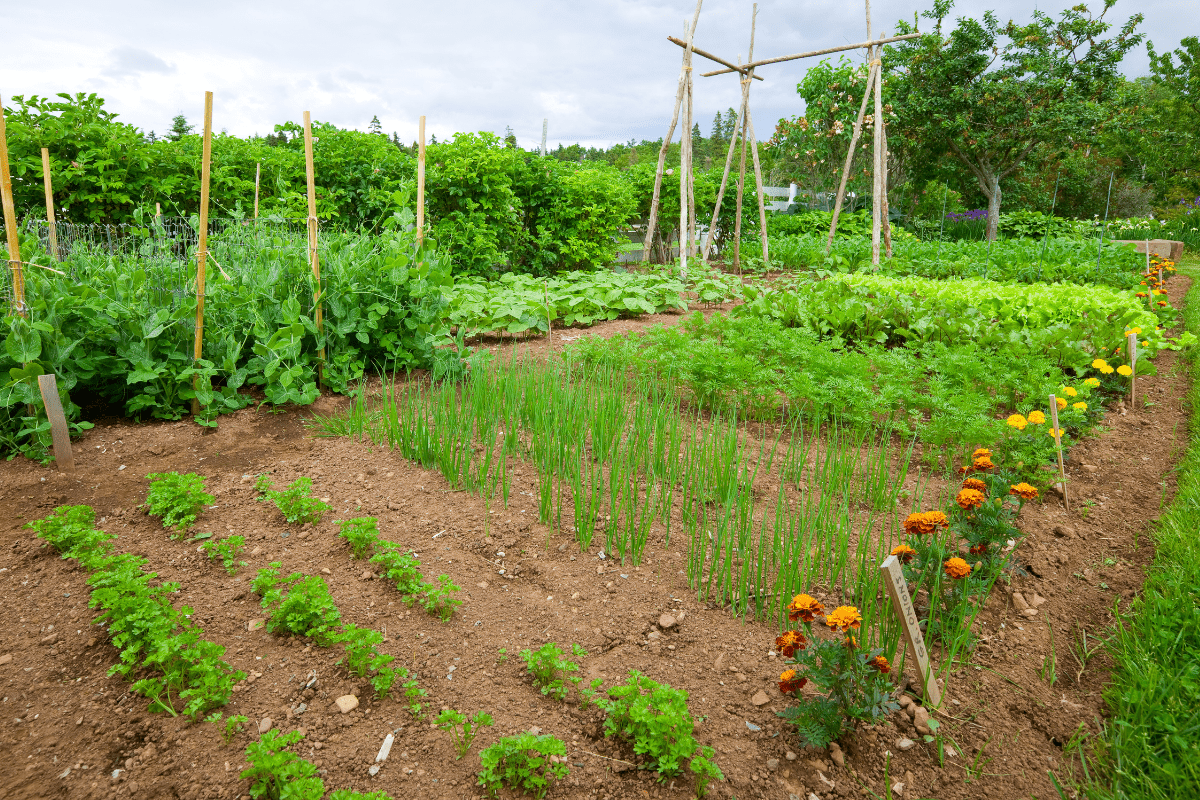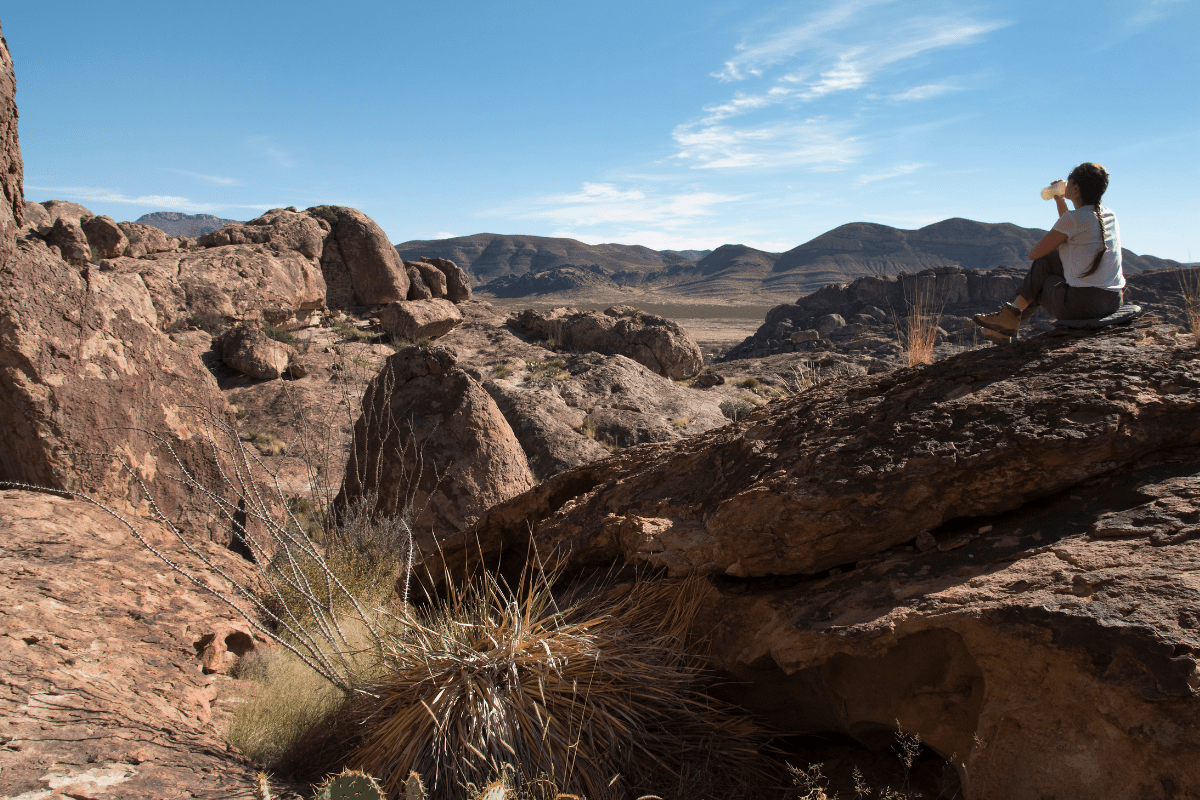If you've ever stood in a Texas grocery store wondering whether those tomatoes are actually in season or driven around looking for a farmers market that may or may not exist anymore, you're not alone. Between our state's wildly different growing zones and the general disconnect from where our food comes from, most of us are pretty clueless about what's actually growing when.
Texas isn't just big, it's basically five different states
Here's the thing nobody tells you when you move to Texas: we don't just have different weather, we have completely different growing universes. The state spans USDA hardiness zones 6 through 10, which in non-gardener speak means that while someone in Amarillo is still scraping frost off their windshield, folks in Brownsville are already harvesting their second round of tomatoes.
Let me break this down by region because understanding this will save you from a lot of disappointment at farmers markets:
North Texas and the Panhandle live in zones 6b to 8b, which means actual winter. Like, plants-will-die-if-you-leave-them-outside winter. Your tomato season runs from June to September if you're lucky, and you better believe those first fall frosts will show up whether you picked all your green tomatoes or not.
Central Texas (that's Austin and San Antonio for those keeping track) sits pretty in zones 8b to 9a. We get a 250-day growing season, which sounds amazing until you realize that includes the part where it's 105°F for three months straight. Our limestone soil has its own special challenges too… basically, it's alkaline enough to make your pH test kit cry.
South Texas is living its best life in zones 9a to 10b. These lucky folks can grow tomatoes from February through December. I'm not jealous. Okay, I'm totally jealous. The Rio Grande Valley is basically the garden of Eden if Eden had humidity that could knock you over.
East Texas gets zones 8a to 9a with humidity that makes everything either grow magnificently or develop seventeen different fungal diseases. The acidic soil there is perfect for things that hate the rest of Texas, like blueberries and azaleas.
West Texas rounds out our tour with zones 7a to 8b and approximately three inches of rain per year (I'm exaggerating, but not by much). If you can grow it there without irrigation, it's basically indestructible.
The kicker? Spring arrives three to four weeks earlier in South Texas than North Texas. Your average last frost could be anywhere from mid-February in Brownsville to late April in the Panhandle. This is why that Facebook gardening group you joined is so confusing… everyone's living in different realities.
What's actually growing when: a month-by-month reality check
Winter isn't dead, it's just subtle
January in Texas is weird. Up north, you're planning gardens while eating grocery store lettuce. Down south, the citrus is hitting peak sweetness and locals are casually picking grapefruit from their backyard trees. This is when I question all my life choices that led to me not living in the Rio Grande Valley.
February brings hope and potato planting. Also onions, which doesn't sound exciting until you taste a fresh spring onion and realize what you've been missing. South Texans are already getting strawberries, and no, I'm not bitter about this at all.
Spring: when Texas shows off
March is when Texas decides to be extra. Those bluebonnets blanking the hillsides? They're just the opening act. This is prime time for cool-season vegetables everywhere in the state. Your lettuce, spinach, and broccoli are living their best lives before the heat murders them sometime in May.
April and May are absolute chaos in the best way. We've got over 5,000 native wildflower species doing their thing, and farmers markets look like someone robbed a rainbow. Strawberries, asparagus, spring onions… it's basically Christmas for people who get excited about vegetables.
This is also when every gardener in Texas engages in the annual tradition of "plant all the summer vegetables before it gets too hot." Spoiler alert: it always gets too hot, but we never learn.
Summer: the survival games
By June, only the strong survive in Texas gardens. Your spring lettuce has bolted, your cilantro has flowered and died, and you're left with the heat lovers: okra, peppers, and eggplant. These are the vegetables that laugh at 100°F days.
July brings watermelons and cantaloupes, which is nature's way of helping us survive the heat. August is peak season for Fredericksburg peaches, and if you haven't had a Hill Country peach, you haven't lived. They're so good they'll make you consider taking up canning just so you can hoard them year-round.
Here's what most people don't realize: August is also when smart gardeners start their fall transplants. While everyone else is complaining about the heat, we're plotting our revenge garden.
Fall: the secret second spring
Y'all, fall gardening in Texas is the best-kept secret in the state. September through November gives us perfect conditions for cool-season crops again. Fall tomatoes are a thing! A glorious, less-buggy, less-diseased thing!
This is when you can grow lettuce without it immediately bolting, when your broccoli actually forms heads instead of just laughing at you, and when many native plants bloom again because Texas plants are overachievers like that.
Finding the good stuff: your local produce treasure map
Farmers markets: where the magic happens
Texas has over 200 farmers markets statewide, which sounds like a lot until you realize how big this state is. Houston's Urban Harvest Farmers Market brings in over 100 vendors from within 180 miles. Austin's markets are militantly local with their producer-only rules, which means that person selling you tomatoes probably picked them yesterday.
Dallas has that gorgeous historic farmers market that's part tourist attraction, part actual market. Pro tip: the real farmers are usually on the shed side, not in the fancy building.
Here's my farmers market survival guide:
- Get there early or everything good is gone
- Bring cash (always bring cash)
- Ask what's peak season RIGHT NOW
- Don't be afraid to look confused
- That weird vegetable might be amazing
- Sample everything they'll let you
- Make friends with your farmers
- They remember who buys regularly
CSAs: vegetable subscriptions that don't suck
Community Supported Agriculture shares typically run $15-30 weekly, which sounds like a lot until you see how much produce you get. It's like Christmas every week, except sometimes Christmas includes kohlrabi and you have to Google what to do with it.
U-pick farms: for overachievers and families
Want to save money and entertain kids at the same time? U-pick farms are your answer. Froberg's Farm near Houston has stuff year-round. Central Texas strawberry farms in spring are basically free childcare that pays you in berries. Prices usually run 30-50% below retail, which is how you justify picking strawberries in 90°F heat.
Regular grocery stores that don't suck at local
H-E-B gets it. With 435+ stores and their GO TEXAN partnership, they actually label local stuff. Their fancier cousin Central Market is even better about seasonal produce. Whole Foods, despite now being owned by the Evil Empire, still maintains decent relationships with Texas growers.
Growing your own: because you're an optimist
Look, I'm going to be real with you. Growing vegetables in Texas is both easier and harder than you think. The good news? Texas A&M AgriLife Extension has 600+ county agents whose entire job is helping you not kill plants. They also have 8,000+ Master Gardener volunteers who will talk your ear off about tomatoes if you let them.
Soil: the foundation of your hopes and dreams
North Texas folks, your heavy clay soil needs help. Like, 2-3 inches of expanded shale worked in help.
Central Texas limestone lovers need to embrace raised beds and sulfur amendments. Just accept that you'll be adding compost annually for the rest of your life.
West Texas gardeners, bless your hearts. Get yourself some 30-50% shade cloth and prepare to water. A lot.
Water: the thing we never have enough of
Drip irrigation is 60% more efficient than sprinklers, which matters when your water bill looks like a mortgage payment. Native plants like Texas sage, esperanza, and lantana will survive on neglect once established, which is my kind of gardening.
Fun fact: every inch of rain on 1,000 square feet equals 623 gallons of water. Get yourself some rain barrels and feel smug every time it storms.
Varieties that won't break your heart
Stick with proven winners for your area. Cherokee Purple tomatoes can handle heat. Drought-tolerant natives are your friends. That exotic variety that needs exactly 72°F and 50% humidity? Save yourself the heartbreak.
Preserving your bounty (or panic)
So you went to the farmers market and bought 20 pounds of peaches because they were so pretty. Now what? Texas A&M's "Preserving the Harvest" program offers 9-session courses on not giving yourself botulism.
East Texas's 80% humidity means you need serious ventilation for dehydrating. West Texas's 30% humidity means you can basically just leave stuff outside and it'll turn into jerky. Adjust accordingly.
Traditional Texas preservation includes:
- Pickled everything (especially okra)
- Pepper jellies that hurt so good
- Fruit preserves your meemaw would approve of
- Salsa. So much salsa.
- Frozen bags of prepped vegetables
- Dehydrated herbs that actually taste like something
Pro tip: Local produce retains more nutrients when preserved than that traveled tomato from who-knows-where. Plus, opening homemade peach preserves in January is basically a jar of summer happiness.
Why this all matters (besides the obvious)
Eating seasonally in Texas means you're getting produce with up to 100% more vitamins than the sad traveled stuff. You're supporting the 1,900+ members of the GO TEXAN program who keep our rural communities alive. You're eating food that actually tastes like food.
Most farmers markets accept SNAP and WIC benefits, making local food accessible to more families. CSAs often have sliding scales or work-share options. This isn't just for wealthy folks with too much time on their hands.
Climate change is real, y'all. Texas has warmed 1.5°F since 1900, and our weather is getting weirder. The Texas Native Seeds Program has developed 41 native seed selections that can handle our new normal. Supporting local agriculture and native plants isn't just trendy… it's survival.
Your seasonal action plan
Here's what you're going to do:
Visit a farmers market this weekend. Buy something you don't recognize. Ask the farmer how to cook it. They love that stuff.
If it's October, plant bluebonnet seeds. If it's July, find some Fredericksburg peaches and eat them over the sink like nature intended. If it's any month ending in -ber, start planning a garden.
Call your county's Master Gardener hotline with your weirdest plant question. They've heard weirder, I promise. Visit a demonstration garden and steal ideas (the ideas, not the plants).
Join a CSA and embrace the mystery vegetable lifestyle. Learn to preserve something, even if it's just freezing herbs in ice cube trays. Support your local farmers, even if it's just buying that overpriced but amazing tomato at the fancy grocery store.
Texas has year-round growing potential, incredible agricultural diversity, and farmers who know their stuff. We just have to pay attention to what's growing when, support the folks growing it, and maybe try growing a little something ourselves. Even if it's just herbs on an apartment balcony that you'll forget to water… hey, at least you're trying.
The secret to seasonal eating in Texas isn't complicated: eat what's growing now, where you are. Buy from people who know your weather. Preserve what you can't eat fast enough. And always, always get the peaches when they're in season. Your February self will thank you.





